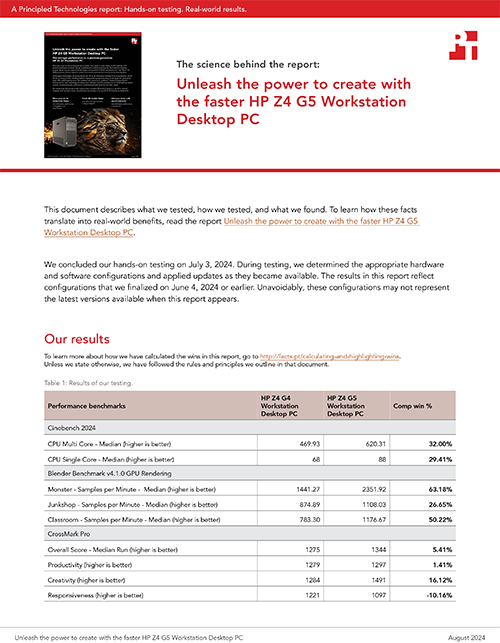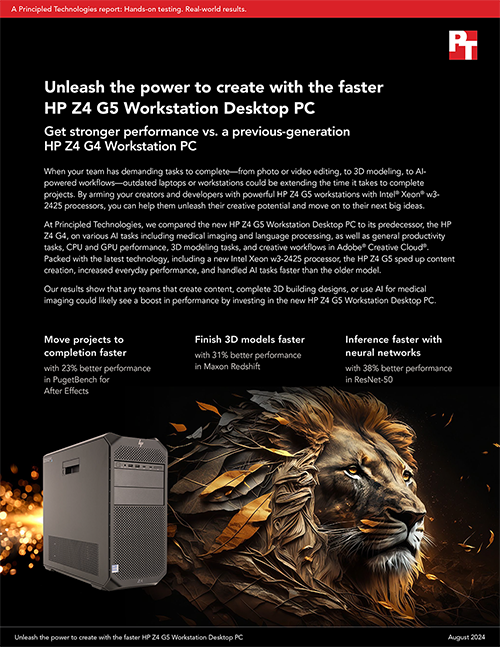
A Principled Technologies report: Hands-on testing. Real-world results.


Unleash the power to create with the faster HP Z4 G5 Workstation Desktop PC
Get stronger performance vs. a previous-generation HP Z4 G4 Workstation PC
When your team has demanding tasks to complete—from photo or video editing, to 3D modeling, to AI-powered workflows—outdated laptops or workstations could be extending the time it takes to complete projects. By arming your creators and developers with powerful HP Z4 G5 workstations with Intel® Xeon® w3-2425 processors, you can help them unleash their creative potential and move on to their next big ideas.
At Principled Technologies, we compared the new HP Z4 G5 Workstation Desktop PC to its predecessor, the HP Z4 G4, on various AI tasks including medical imaging and language processing, as well as general productivity tasks, CPU and GPU performance, 3D modeling tasks, and creative workflows in Adobe® Creative Cloud®. Packed with the latest technology, including a new Intel Xeon w3-2425 processor, the HP Z4 G5 sped up content creation, increased everyday performance, and handled AI tasks faster than the older model.
Our results show that any teams that create content, complete 3D building designs, or use AI for medical imaging could likely see a boost in performance by investing in the new HP Z4 G5 Workstation Desktop PC.
How we tested
Before we started testing, we set the G4 workstation Windows power plan to “high performance” and the G5 workstation power plan to “ultimate performance,” the highest-performance option available for both workstations. Other than making and verifying those changes, we used out-of-box OEM performance settings. To see how much the increased CPU and GPU capabilities on the G5 boosted performance, we tested similar configurations for each generation.

We ran a range of AI/machine learning (ML) and performance workloads three times each and report the median results.
AI/ML workloads
We ran several MLPerf Inference Benchmark Suite machine learning models in the offline scenario, where the workstations can process the data in any order, without latency constraints.
- ResNet-50, which measures image classification and detection performance
- 3D U-Net, which measures medical imaging and 3D image segmentation performance
- RNN-T, which measures speech recognition performance
- BERT, which measures natural language processing performance
Everyday and content creation workloads
- Cinebench 2024 to compare CPU single- and multicore performance
- Blender to compare GPU rendering, multi-GPU acceleration, and ray-tracing performance
- CrossMark™ Pro to compare general performance in the areas of productivity, creativity, and responsiveness
- PugetBench benchmarks to compare photo- and video-editing performance with Adobe Creative Cloud apps
- Maxon Redshift to compare 3D rendering performance
The benchmark scores we report reflect the specific configurations we tested. Any difference in the configurations you test, as well as network traffic, or software additions, can affect these results. For a deeper dive into our testing parameters and procedures, see the science behind the report.
Speeding up AI/ML workloads
A 2024 survey reported that 55% of organizations polled are currently using some form of AI implementation in their business workflows.3 With so many applications for machine learning—from medical imaging to speech prediction to virtual assistants to facial recognition—companies can benefit from choosing workstations with the processing power to handle these demanding workloads now and as they develop new workflows. We tested both workstations on a variety of ML workloads to show what the HP Z4 G5 has to offer organizations using AI and those who may want to do so in the future.
Classifying images in less time with ResNet-50
ResNet-50 is an AI image classification and detection model that backs computer vision applications such as facial recognition, autonomous cars, plant species classification, edge computing, sports performance analysis, and production-line automation.4
By classifying images faster, the HP Z4 G5 could help healthcare professionals make faster diagnoses, help scientists discern damage after natural disasters, and more.

Measuring medical imaging and 3D image segmentation performance with 3D U-Net
One key application for AI/ML has been medical imaging: AI computing can give healthcare professionals detailed information about their patients, so they might make a diagnosis sooner. We compared the AI performance of the workstations using the 3D U-Net model, which is “a convolutional neural network for 3D image segmentation” that “allows for seamless segmentation of 3D volumes, with high accuracy and performance, and can be adapted to solve many different segmentation problems.”5 Our tests showed that the HP Z4 G5 sustained more samples per second than the legacy system, which means that providers might not wait as long for answers.

Assessing speech recognition performance with RNN-T
Recurrent Neural Networks (RNN) maintain the sequence of input in convolutional neural networks. RNN models have many applications, including speech recognition, prediction problems, call center analysis, image description generation, and more.6 Comparing RNN-T r4.0 model performance, we found that the HP Z4 G5 offered more samples per second than the legacy system, indicating that it is also better equipped for this type of AI model.

Speeding up answers from virtual assistants, analyzing clinical notes, and more with BERT
BERT, which stands for Bidirectional Encoder Representations from Transformers, is a large language model (LLM) that sorts and analyzes text to make predictions. Many people use BERT or similar LLMs daily, even if they’ve never heard of BERT. It is the AI behind some virtual assistants, and handles tasks such as question answering, text generation, language translations, and more.7 In our tests with the BERT 99 model, the HP Z4 G5 analyzed text faster, which means that clinicians reading notes can get answers faster about the data they’ve amassed.

Boosting everyday performance to create content faster
The level of system performance that users require depends upon their particular workflows. For those who multitask, content creators who work with audio/video, and engineers who need to render complex models, fast workstation performance is vital to getting projects done. We tested the systems using many kinds of high-performance benchmarks to show how the new HP Z4 G5 can speed up work on these kinds of tasks.

Using 3D rendering to evaluate the HP Z4 G5
Cinebench 2024 is an industry-standard benchmark that “utilizes the power of Redshift, Cinema 4D’s default rendering engine, to evaluate your computer’s CPU and GPU capabilities.”8 Higher CPU single- and multi-core scores in Cinebench 2024 indicate that a system can offer stronger performance for tough tasks such as rendering, which can help creators, engineers, and even data scientists finish their graphics-heavy tasks more quickly.

Speeding up 3D rendering for quicker modeling and design
Taxing 3D rendering tasks require strong GPU and CPU performance to complete designs in a timely manner—if your team’s systems don’t render fast enough, you may miss important deadlines and then future opportunities.
We used two different tools to measure 3D rendering on the systems: Blender 4.1 GPU (using the CUDA engine) and Maxon Redshift. Across these tests, the HP Z4 G5 Workstation Desktop PC completed rendering tasks faster than the legacy system, which means that it can shorten the time to render a scene in your latest animated adventure or for completing building designs.

Create content faster in Adobe Creative Cloud
Creators worldwide rely on Adobe Creative Cloud products—which include Adobe After Effects®, Adobe Photoshop®, and Adobe Premiere Pro®—to turn their ideas into reality. We used the PugetBench benchmark to compare the performance of the workstations on these creative tasks, finding again that the new HP Z4 G5 Desktop Workstation PC can help creators shave time off editing and creation tasks.

Assessing everyday performance for users who multitask
To compare general productivity performance of the two systems, we used CrossMark Pro, “a cross-platform benchmark that enables direct comparison of desktops and touch enabled devices...”9 CrossMark uses real-world applications including multitasking, email creation/management, document/photo/video editing, scientific simulations, forecasting spreadsheets, and web browsing capabilities. As our results show, the HP Z4 G5 was better poised to tackle complex daily tasks than the legacy system, once again showing its suitability to make a positive impact on workflows for a wide variety of users.


Conclusion
Whether your organization employs professionals creating content for your brand, engineers rendering 3D models of city landscapes, or data scientists using AI to pilot your company into the future, supplying your staff with high-performing HP Z4 G5 workstations with Intel Xeon w3-2425 processors can help them unleash their creative potential. In our barrage of demanding benchmarks, the HP Z4 G5 Workstation Desktop PC provided stronger performance across multiple workloads compared to the previous-generation HP Z4 G4, which means it can help your team finish their complex tasks faster and move projects to completion.
- HP, “HP Z4 Overview G5,” accessed July 1, 2024, https://www.hp.com/us-en/workstations/z4.html.
- Intel, “Intel® Xeon® W Processors,” accessed June 26, 2024, https://www.intel.com/content/www/us/en/products/details/processors/xeon/w.html.
- Emily Matzelle, “Top Artificial Intelligence Statistics and Facts for 2024,” accessed July 22, 2024, https://connect.comptia.org/blog/artificial-intelligence-statistics-facts.
- Jye Satwell-Rickson, “What Is Computer Vision?” accessed July 7, 2024, https://builtin.com/machine-learning/computer-vision.
- NVIDIA, “3D-UNet Medical Image Segmentation for TensorFlow,” accessed July 3, 2024, https://catalog.ngc.nvidia.com/orgs/nvidia/resources/unet3d_medical_for_tensorflow.
- Sampriti Chatterjee, “What is Recurrent Neural Network?” accessed July 7, 2024, https://www.mygreatlearning.com/blog/recurrent-neural-network/.
- Javier Canales Luna, “What is BERT?” accessed July 7, 2024, https://www.datacamp.com/blog/what-is-bert-an-intro-to-bert-models.
- Maxon, “Cinebench,” accessed July 3, 2024, https://www.maxon.net/en/cinebench.
- BAPCo, “CrossMark,” accessed July 3, 2024, https://bapco.com/crossmark/.
This project was commissioned by HP.
August 2024
Principled Technologies is a registered trademark of Principled Technologies, Inc.
All other product names are the trademarks of their respective owners.
Principled Technologies disclaimer

Principled Technologies is a registered trademark of Principled Technologies, Inc.
All other product names are the trademarks of their respective owners.
DISCLAIMER OF WARRANTIES; LIMITATION OF LIABILITY:
Principled Technologies, Inc. has made reasonable efforts to ensure the accuracy and validity of its testing, however, Principled Technologies, Inc. specifically disclaims any warranty, expressed or implied, relating to the test results and analysis, their accuracy, completeness or quality, including any implied warranty of fitness for any particular purpose. All persons or entities relying on the results of any testing do so at their own risk, and agree that Principled Technologies, Inc., its employees and its subcontractors shall have no liability whatsoever from any claim of loss or damage on account of any alleged error or defect in any testing procedure or result.
In no event shall Principled Technologies, Inc. be liable for indirect, special, incidental, or consequential damages in connection with its testing, even if advised of the possibility of such damages. In no event shall Principled Technologies, Inc.’s liability, including for direct damages, exceed the amounts paid in connection with Principled Technologies, Inc.’s testing. Customer’s sole and exclusive remedies are as set forth herein.

 Twitter
Twitter Facebook
Facebook LinkedIn
LinkedIn Email
Email




